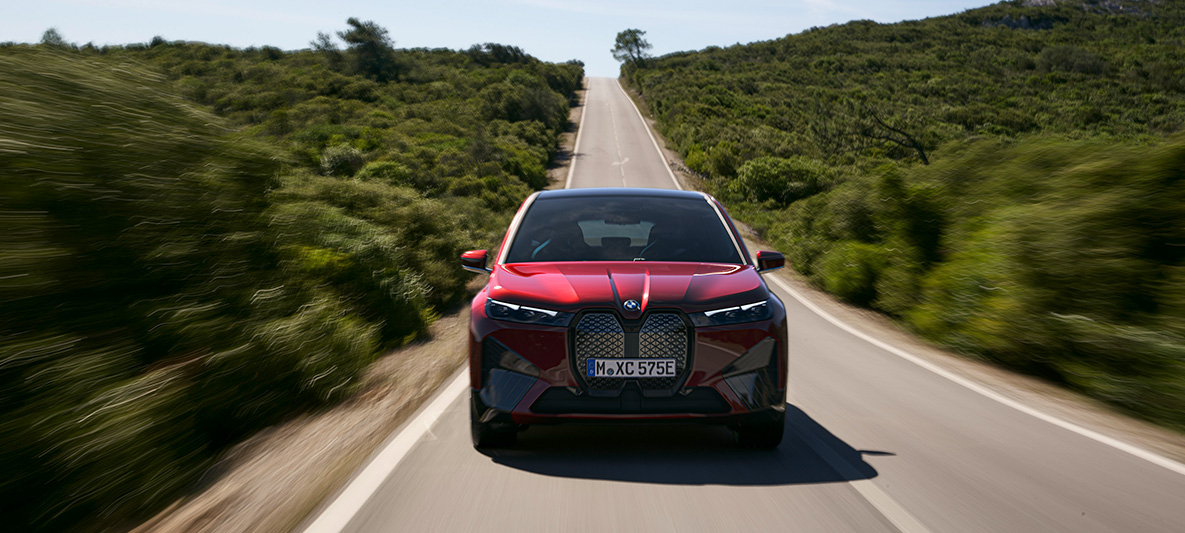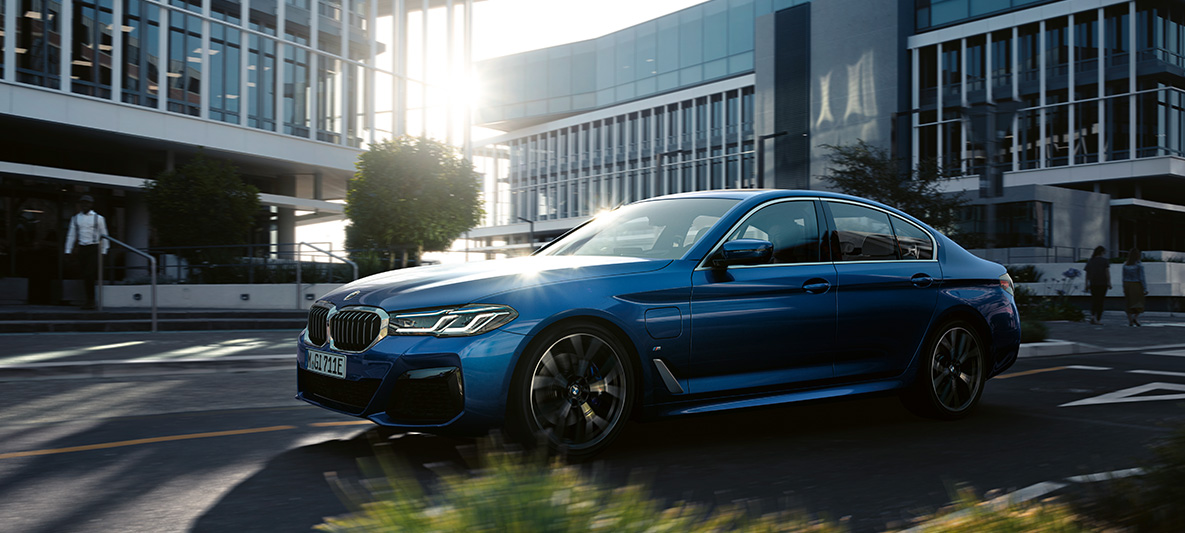Our tool for managing your permission to our use of cookies is temporarily offline. Therefore some functionality is missing.

THE RANGE OF BMW ELECTRIC CARS AND PLUG-IN HYBRIDS.
Uncompromising range comfort.
For us, freedom means boundless mobility. Fortunately, the times in which the purely electric range was just far enough to reach the nearest supermarket have now come to an end. Increasingly efficient high-voltage batteries make electrified driving more than fit for everyday use and in fact suitable for every lifestyle. And thanks to the continuously expanding public charging network of BMW Charging, you not only have charging stations from a wide range of operators in cities at your disposal but also high-power charging stations exclusively for your BMW electric car on motorways. Ultimately, the world is open to those who think sustainably – and from now on also to those who wish to travel sustainably. Join us to explore the world of range comfort for BMW electric and plug-in hybrid vehicles.

ON HOLIDAY WITH YOUR BMW ELECTRIC CAR!
You’ve chosen your holiday destination, the suitcases are packed and your BMW iX with its purely electric range of more than 600 km (according to the WLTP test cycle) is standing in your driveway ready for action. In order to get the optimum out of your electric car from the outset, you have already prepared the interior and the battery for the journey or the settings in the vehicle menu. Thanks to the “preconditioning” process, your domestic mains electricity is used to adjust the temperature of the interior and battery while the vehicle is still charging from your BMW Wallbox. Alongside external environmental factors such as the outside temperature, your personal driving style also affects the efficiency of the high-voltage battery in your vehicle and hence your available range. A generally anticipatory and uniform driving style allows you to extract the maximum from your battery. Once arrived at your charging stop, you unlock and charge your BMW iX easily and conveniently You can now continue to your destination, completely free of exhaust fumes and local emissions.

COMMUTING WITH YOUR BMW PLUG-IN HYBRID!
On the previous evening, you connected your BMW 5 Series Sedan 530e plug-in hybrid with the BMW Wallbox to charge up and set the precise time at which you want to take off to work. Thanks to the “preconditioning” process, your domestic mains electricity is used to adjust the temperature of the interior and the battery while the vehicle is still charging from your BMW Wallbox. This means your vehicle is ideally prepared for the journey, and you have its full range at your disposal. Back at home at the end of the working day, you simply reconnect your BMW 530e Sedan to the BMW Wallbox and enjoy the rest of the evening – while looking forward to that next locally emission-free trip to work.
Range indicator

HOW TO: MAXIMIZE THE RANGE OF YOUR PHEV.
FAQ: THE MOST IMPORTANT QUESTIONS AND ANSWERS ON RANGE.
-
What factors affect the high-voltage battery of my BMW electric car and plug-in hybrid?
![BMW Range FAQ BMW e-mobility BMW Range FAQ]()
One important external factor influencing the performance and capacity of a battery is the temperature. As you probably know from your mobile phone battery, the performance is restricted in cold and hot temperatures. In your vehicle, however, this temperature influence is largely minimised by means of optimised operating strategies. And did you know that the capacity also yields information on the range you may have? Apart from temperature, other influential factors are devices in use, such as the air conditioning, the load carried and your driving style.
-
What is the best possible way to prepare my BMW electric car and my plug-in hybrid for the next journey?
In order to get the maximum out of your vehicle from the outset, it is advisable to precondition the battery and vehicle interior. As cooling and heating require electric energy, this process should be carried out while the vehicle is still charging. To do this, simply set the desired departure time and conditioning requirements or in the menu of the vehicle itself. When the time comes to depart, the battery will then have attained the ideal operating temperature and the climate of the interior will also be at an optimum.
-
How does my driving style affect the range of my BMW electric car and plug-in hybrid?
As is the case for a vehicle with a conventional propulsion system, driving style also affects the range in an electric car. As a general rule, an anticipatory, relaxed and uniform style of driving optimises your range. If, for example, you reduce your speed on the motorway from 130 km/h to 110 km/h, you can noticeably increase your range. During recuperation, that means whenever you lift your foot from the accelerator pedal, kinetic energy is converted into electrical energy and fed into the battery – and as a result you gain further kilometres in range.
-
What happens if my destination is outside of the electric range?
If your navigation destination is outside of the electric range, a charging option is automatically added to your route or alternatively you get suggestions for relevant charging stops.*
*The availability varies depending on the model and equipment.
FUEL CONSUMPTION AND CO2 EMISSIONS.
* The My BMW App is compatible with all BMW vehicles from model year 2014 and later. This requires the ConnectedDrive Services option and a suitable smartphone. The availability and functions of the My BMW App vary according to the market.
BMW iX(1):
Power consumption in kWh/100 km (combined): under 21
Fuel consumption in l/100 km (combined): 0
CO2 emissions in g/km (combined): 0
BMW iX3:
Fuel consumption in l/100 km (combined): 0
CO2 emissions in g/km (combined): 0
Electric consumption in kWh/100 km (combined): 17.8–17.5
BMW 3 Series Sedan plug-in hybrids:
Fuel consumption in l/100 km (combined): 2.0–1.5
CO2 emissions in g/km (combined): 45–35
Energy consumption in kWh/100 km (combined): 15.9–13.9
BMW 3 Series Touring plug-in hybrids:
Fuel consumption in l/100 km (combined): 2.2–1.7
CO2 emissions in g/km (combined): 49–38
Energy consumption in kWh/100 km (combined): 15.8–14.5
BMW 5 Series Sedan plug-in hybrids:
Fuel consumption in l/100 km (combined): 2.3–1.6
CO2 emissions in g/km (combined): 53–36
Energy consumption in kWh/100 km (combined): 16.3–13.8
BMW 5 Series Touring plug-in hybrids:
Fuel consumption in l/100 km (combined): 2.4–1.8
CO2 emissions in g/km (combined): 54–42
Electric consumption in kWh/100 km (combined): 16.7–15.4
BMW X5 xDrive45e:
Fuel consumption in l/100 km (combined): 2.0–1.7
CO2 emissions in g/km (combined): 46–38
Energy consumption in kWh/100 km (combined): 23.5–21.3
BMW X3 xDrive30e:
Fuel consumption in l/100 km (combined): 2.4–2.1
CO2 emissions in g/km (combined): 54–48
Energy consumption in kWh/100 km (combined): 17.1–16.4
BMW 2 Series Active Tourer 225xe:
Fuel consumption in l/100 km (combined): 1.9
CO2 emissions in g/km (combined): 42
Energy consumption in kWh/100 km (combined): 13.5
BMW 7 Series Sedan plug-in hybrids:
Fuel consumption in l/100 km (combined): 2.5–2.1
CO2 emissions in g/km (combined): 57–48
Energy consumption in kWh/100 km (combined): 16.2–15.1
BMW X1 xDrive25e:
Fuel consumption in l/100 km (combined): 1.9
CO2 emissions in g/km (combined): 43
Energy consumption in kWh/100 km (combined): 13.8
BMW X2 xDrive25e:
Fuel consumption in l/100 km (combined): 2.1–1.9
CO2 emissions in g/km (combined): 47–43
Energy consumption in kWh/100 km (combined): 14.2–13.7
The values of the vehicles labelled with (1) are preliminary.
The information on fuel consumption, CO2 emissions and energy consumption has been determined in accordance with the prescribed measurement procedure VO (EU) 715/2007 in the version applicable at the time of type approval. The figures refer to a vehicle with basic configuration in Germany and the range shown considers optional equipment and the different size of wheels and tires available on the selected model.
Further information about the official fuel consumption and the official specific CO2 emissions for new passenger automobiles can be found in the 'New Passenger Vehicle Fuel Consumption and CO2 Emission Guidelines', which are available free of charge at all sales outlets and from DAT Deutsche Automobil Treuhand GmbH, Hellmuth-Hirth-Str. 1, 73760 Ostfildern, Germany and on https://www.dat.de/co2
The values are already based on the new WLTP regulation and are translated back into NEDC-equivalent values in order to ensure the comparison between the vehicles. For vehicle related taxes or other duties based (at least inter alia) on CO2-emissions the CO2 values may differ to the values stated here.
Fuel consumption and CO2 emissions.
-
BMW iX(1):
Power consumption in kWh/100 km (combined): under 21
Fuel consumption in l/100 km (combined): 0
CO2 emissions in g/km (combined): 0BMW iX3:
Fuel consumption in l/100 km (combined): 0
CO2 emissions in g/km (combined): 0
Electric consumption in kWh/100 km (combined): 17.8–17.5BMW 5 Series Sedan plug-in hybrids:
Fuel consumption in l/100 km (combined): 2.3–2.0
CO2 emissions in g/km (combined): 53–46
Energy consumption in kWh/100 km (combined): 17.6BMW 2 Series Active Tourer 225xe:
Fuel consumption in l/100 km (combined): 2.4
CO2 emissions in g/km (combined): 56
Energy consumption in kWh/100 km (combined): 17.4The values of the vehicles labelled with (1) are preliminary.
The values of fuel consumptions, CO2 emissions and energy consumptions shown were determined according to the European Regulation (EC) 715/2007 in the version applicable at the time of type approval. The figures refer to a vehicle with basic configuration in Germany and the range shown considers optional equipment and the different size of wheels and tires available on the selected model.
The CO2 efficiency specifications are determined according to Directive 1999/94/EC and the European Regulation in its current version applicable. The values shown are based on the fuel consumption, CO2 values and energy consumptions according to the NEDC cycle for the classification.
For further information about the official fuel consumption and the specific CO2 emission of new passenger cars can be taken out of the „handbook of fuel consumption, the CO2 emission and power consumption of new passenger cars“, which is available at all selling points and at https://www.dat.de/angebote/verlagsprodukte/leitfaden-kraftstoffverbrauch.html.

